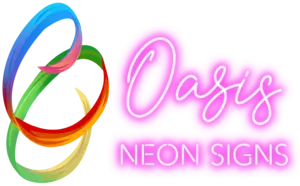
Is Neon Bad for The Environment? Breaking Down the Bright Facts
Share
Is neon bad for the environment? That’s probably the number one burning question amongst enthusiasts who just discovered the beauty of the glowing tubes of nostalgia. They’ve become so popular in this modern age and are lighting up literally everything, from your favorite dive bars to contemporary wedding venues.
Neon signs are harmless (I mean, it’s just gas in a tube, right?), but there’s more going on beneath that buzz of nostalgic glow. If you’ve decided to give your new-found decorative piece a chance but are wondering about its safety in the environment, you’re going to find out for sure if it's safe. We’ll break down whether neon impacts the environment and find out if it’s an eco-hazard in disguise.
Is Neon Bad For The Environment?

Before jumping deeper into the safety of neon, let’s first find out the safety of the most abundant element in those glowing tubes. Neon gas is a naturally occurring element and isn’t as abundant as you might have thought—dry air has a negligible amount, about 0.0018% by volume. As part of the group of inert gases in the periodic table, neon gas is harmless and non-reactive.
Neon Creation Process: A Gas-guzzling Affair?
Now, back to neon signs. These adorable glowing pieces get their name from neon gas, which is the main source of the iconic red-orange glow. Harvesting this rare gas from the atmosphere is a demanding process that needs a lot of energy.
What’s more, different types of neon signs are also made using other inert gases, such as krypton, argon, and helium. In some situations, mercury vapor is also used. Mercury, in particular, has toxic properties and needs proper handling. If mishandled during the manufacturing of the neon signs or disposal, it can cause contamination of water sources and soil. Not so neon now, huh?
How About Neon’s Energy Efficiency?
Is neon bad for the environment? To answer this question conclusively, it’s imperative to look at another aspect of neon signs: energy consumption. Neon signs can actually be pretty efficient in consuming electricity. However, the efficiency level largely relies on how you power and maintain them.
Neon signs can consume up to 20 watts per foot of tubing, while larger signs can consume even much more. Now, consider the number of these signs that stay lit 24/7, just to spell out “Now Open” in striking neon pink. That adds up! However, if you opt for LED neon alternatives (about 3-4 watts consumption per foot), on the other hand, you can use up to 75% less electricity.
The Toxic Side of Traditional Neon Signs
By now, you must have drawn a conclusion about the safety of traditional neon lights in the environment. But just to be clear about where you stand, let’s look at the toxic side of these neon signs. Traditional neon signs mostly rely on mercury vapor to attain their signature nostalgic glow.
Even though encased in a glass, the mercury vapor can still pose a hazard if the sign breaks, or isn’t disposed of properly after reaching its end of life. Mercury exposure is linked to serious health and environmental problems, such as contamination of soil and water sources, damage to wildlife, and air pollution. It’s not just bad for the environment; it’s hazardous to animals and people as well.
Beyond mercury, traditional neon signs also involve the use of phosphor coatings, which are also hazardous to the environment. These elements may not be toxic while the neon sign is in use. But immediately it breaks or reaches the end of life, the owner has to deal with several risk concerns. These are what make traditional neon signs a threat to health and the environment.
What Happens When the Glow of Neon Signs Fade?

Another important consideration that you have to worry about with traditional neon signs is disposal once they reach their end of life. Disposing of these signs goes beyond just tossing them in the bin; you need to ensure it’s done properly to avoid mercury contamination.
Carelessly dumping them in a landfill also poses the risk of releasing toxic mercury into the environment. Instead, they should be taken to a specialized recycling facility. That’s another problem to deal with because neon sign recycling isn’t that easy to come across.
Also, if a traditional neon sign is broken, it’s impossible to repurpose or recycle it. But with LED neon signs, you won’t have to deal with the problem of disposal since they’re more recyclable and easier to dispose of when they cease to function.
Why are Traditional Neon Signs Still in Use Despite Their Safety Risks?
This is probably the question you’re asking yourself. Despite the environmental safety concerns surrounding neon signs, they hold a nostalgic charm that appeals to some people. They emit a soft, inviting charm that soothes, the reason why you’ll find them in those old-school settings, such as pubs.
Also, some vintage neon collectors prefer the old-school feel of these signs, which is why they still haven’t vanished yet entirely. However, with the growing concerns and awareness of environmental impact, most people are turning to more efficient LED neon signs.
When you switch to LED neons, you won't need to worry about questions like “Is neon bad for the environment?” That’s because they’re safer. Also, LED neon signs not only mimic the nostalgic glow of traditional neon signs, they also offer a wider choice of more vibrant colors.
The Bright Side: LED Neon to the Rescue the Environmental Aspects

With technological advancements, LED neon signs come to the rescue. When comparing neon vs LED signs, LED neons are more energy efficient, do not contain a single trace of toxic elements, and are environment-friendly. Instead of using neon gas and toxic mercury, they’re powered by light-emitting diodes (LED).
As you already know, LED is much more durable, consumes less power, and emits little to no heat. When integrated to make LED neon signs, they can produce almost the same vibrant and nostalgic effect as traditional neon signs. What’s more, LEDs can last more than 25,000 hours when compared to traditional neon’s 10,000 hours.
In considering the durability of LED neon signs, since they’re made from flexible plastic tubing instead of fragile glass, they’re less prone to breakage. This means you can use them even in high-traffic areas without worrying about something knocking them.
Why You Should Ditch Traditional for LED Neon Signs
Are LED lights good for the environment? Up to this level, we cannot stress enough how beneficial LED neon signs are. You’ve already seen the threat posed by traditional neon signs to the environment. But here are the reasons why you should consider making the switch to LED neon signs if you haven’t.
Energy Efficiency
As we’ve mentioned, LED neon signs are a greener alternative as they consume up to 75% less energy than traditional neon signs. When you make the switch, you’ll not only be slashing several hundred dollars off your annual electric bill, but you’ll also be lowering your overall carbon footprint.
Environmental Safety
LED neon signs don’t contain mercury, phosphor coatings, or any other harmful elements. So, no worries about leaking these chemicals to your environment. Generally, LED neon is safer since it’s made using flexible plastic tubing to reduce the breakage risk.
Lifespan
LED neon signs are highly durable that you’ll simply install and forget about them. A typical neon sign can last about 25,000 hours, reducing the need for frequent replacements. This goes a long way to save you money and reduce waste generation, ensuring you get back the real value for your money.
Customization and vibrant colors
This is probably one of the biggest perks of choosing LED neon signs. If you think your business color theme is the rarest, don’t be surprised to learn that LED neon signs can match the exact hue. With LED neon, you have a wider spectrum of color hues to choose from, unlike the limited traditional neon signs.

Since they’re technology-driven, you’ll get the option of customizations, such as syncing the glow to music beats or the movement of people. So, whether you’re throwing a birthday party, decorating your wedding venue, or adding flair to your home décor, you’ll have endless customization possibilities. All without posing harm to the environment.
Should You Ditch Traditional Neon Completely?
Now that you’ve found an answer to the question “Is neon bad for the environment,” should you ditch it completely? Well, if you’re still using the traditional mercury-laden neon signs with high energy consumption and are difficult to recycle, yes you should. If you were planning to acquire one, then it’s better to consider more viable and eco-friendly alternatives: LED neon signs.
With LED neon signs, you won't be saying goodbye to the beautiful nostalgic glow. Just swap your traditional neon sign for LED neon signs to cut your energy costs and help protect the planet.
Conclusion
Is neon bad for the environment? If you look at the risks that come with disposal, yes, traditional neon signs are harmful to the environment. Due to their mercury content and phosphor coating, these signs can pose safety risks when they reach their end of life.
Since the invention of neon signs it have been an integral part of illuminated spaces for more than a century. However, with the rising environmental concerns, the traditional form of neon signs is facing a dimming future. But you don’t have to say goodbye to the beautiful glow entirely; LED neon signs offer a more sustainable way forward.
Go ahead and explore more energy-efficient and environmentally safe LED neon signs for your shop, home décor, birthday or wedding at Oasis Neon Signs.
